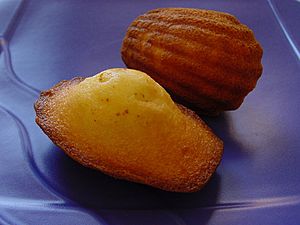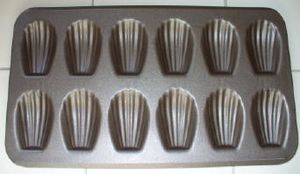Madeleine (cake) facts for kids
 |
|
| Alternative names | Petite madeleine |
|---|---|
| Type | Cake |
| Place of origin | France |
| Region or state | Commercy and Liverdun, Lorraine |
| Main ingredients | Flour, sugar, eggs, almonds or other nuts |
The madeleine (French pronunciation: [mad.lɛn]) or petite madeleine ([pə.tit mad.lɛn]) is a small, traditional cake from Commercy and Liverdun. These towns are in the Lorraine region of northeastern France.
Madeleines are tiny sponge cakes. They have a special shell-like shape. This shape comes from baking them in pans with shell-shaped molds. You can find these pans in many stores. You don't need any other special tools to make madeleines.
The batter for madeleines is a type called génoise. This is a light sponge cake batter. The flavor is similar to sponge cake but often lighter. Traditional recipes use very finely ground nuts, usually almonds. Some variations add lemon zest for a strong lemon taste.
British madeleines are a bit different. They also use a génoise sponge. But they are baked in dariole molds. After baking, they are covered in jam and shredded coconut. They often have a glacé cherry on top.
Contents
History of Madeleines
Fun Legends About Madeleines
Many fun stories explain how madeleines were "invented." Most stories involve a woman named Madeleine. She was usually a cook for an important person in Lorraine's history.
One story says Madeleine Paulmier was a cook in the 1700s. She worked for Stanislaus I, who was the duke of Lorraine and a former king of Poland. In 1755, Louis XV, the duke's son-in-law, loved these little cakes. He named them after Madeleine. His wife, Maria Leszczyńska, then brought them to the royal court at Versailles. The royal family loved them, and soon madeleines became popular all over France.
Other stories connect the cake to a famous pilgrimage. This is the journey to Santiago de Compostela in Spain. One tale says a pilgrim named Madeleine brought the recipe back from her trip. Another says a cook named Madeleine gave shell-shaped cakes to pilgrims passing through Lorraine.
Some stories don't place the invention in Lorraine. They suggest a pastry chef named Jean Avice created them. He worked for Prince Talleyrand in the 1800s. Avice supposedly baked small cakes in aspic molds, creating the madeleine.
First Recipes and Popularity
The word "madeleine" for a small cake first appeared in France around the mid-1700s. In 1758, someone mentioned "cakes à la Madeleine."
Madeleines became very popular in the early 1800s. This was partly because metal molds were becoming more common for baking. Famous food writers like Antonin Carême and Grimod de la Reynière wrote about them.
In Commercy, madeleines started being made in large amounts around the 1760s. They were sold at the Commercy train station. This helped them spread quickly across France. By the late 1800s, madeleines were a common treat for many French families.
Madeleines in Recent Times
In 1971, the famous chef Julia Child showed how to make madeleines. She did this on her TV show, The French Chef.
In 2006, madeleines were chosen to represent France. This was part of the Café Europe event. This event celebrated Europe Day and European culture.
See also
 In Spanish: Magdalena (alimento) para niños
In Spanish: Magdalena (alimento) para niños


